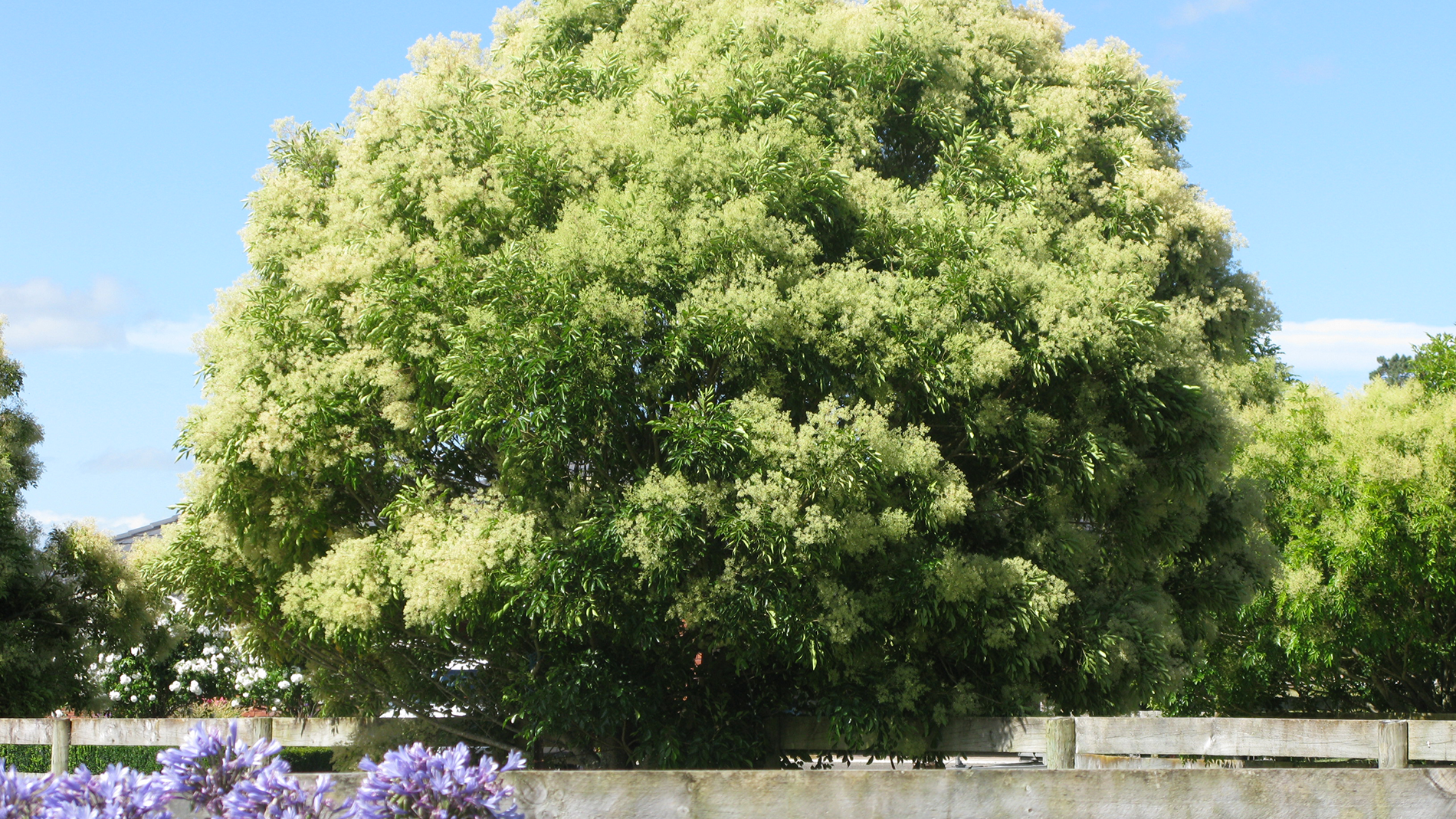| Management programme |
| Site-led (Wetlands) Chinese privet only |
| Objectives |
| Provide advice and information on the identification and control of privet species and reduce the impacts of Chinese privet in wetlands clear or being cleared of it. |
| Impacts |
| Biodiversity, social and cultural wellbeing |
There are four species of privet found in New Zealand, all of which are evergreen shrubs or trees. These include tree privet (Ligustrum lucidum), Chinese privet (Ligustrum sinense), Californian privet (Ligustrum ovalifolium) and common privet (Ligustrum vulgare). Both tree privet and Chinese privet are tolerant of drought, as well as cold and wet conditions.

What does it look like?
Tree privet
Flowers
- Small, cream-coloured flowers that are strongly scented and appear from January to March.
Fruits/seeds
- Dark purple-black berries.
- Seeds spread by birds.
Leaves
- Glossy leaves that are dark green on top and paler green underneath.
Chinese privet
Flowers
- Small white flowers that are strongly scented and appear from September to December.
Fruits/seeds
- Dark purple-black berries.
- Seeds spread by birds.
Leaves
- Leaves are small and dull green with wavy edges.
Why is it a pest?
Privet is an environmental pest, rapidly invading roadsides, urban hedges and gardens, open disturbed sites and the margins of natural areas, including wetlands. All species have wide environmental tolerance, and produce masses of highly viable, bird-dispersed seeds that can germinate to form carpets of shade-tolerant seedlings. The leaves and berries of all species are poisonous to animals and people. Its strong scented flowers are an irritant or allergen to some people.
Tree privet is evergreen, tall (to 15+ metres), fast growing and long-lived, becoming a persistent canopy tree that can displace native species and eventually dominate areas of shrubland and forest.
Chinese privet is an evergreen or semi-deciduous shrub or small tree (to 5 metres), with wavy-edged leaves. Shorter-lived than tree privet, it forms dense stands that continuously replace and prevent the establishment of native species.
Privet species (particularly Chinese privet and tree privet) are widespread and common in the Waikato region.
Control methods
Physical control
- Pull out or dig up small plants, being careful to remove the entire root system so it doesn’t regrow.
- If you have to cut down a larger plant, you will need to treat the stump with herbicide to stop it from regrowing.
- Desirable plant species such as native shrubs and grass should be established where soil has been disturbed. This will suppress the germination of privet and other weeds.
- To reduce the impact of privet on asthma or hay fever, regularly trim hedges to prevent flowering.
- Take note of underground services in your area if removing privet roots. Be sure to check the location of your service pipes and cables before you commence digging.
Herbicide control
Frilling
With a sharp chisel or axe, make a deep cut into the sapwood at regular intervals around the base of the tree. Immediately saturate the cuts with herbicide.
Basal treatment of trunk
This can be done all year round. Apply with a paintbrush or low pressure sprayer using a solid cone nozzle. Liberally treat the full circumference and the basal parts of the shrub or tree trunk in a manner that thoroughly wets at least 2-3 times the diameter of the lower stem or trunk, including the root collar area.
Cut stump treatment
This can be done all year round. Cut the tree down, leaving a stump no higher than 5cm above ground level. Immediately paint herbicide over the entire stump surface, including the sides.
Cut and inject
This can be done all year round. Holes are drilled sloping into the sapwood at regular intervals around the tree. Inject herbicide into holes. A drench gun or similar can be used.
Spray application
This can be done all year round. Spraying is more suitable for smaller or seedling plants but also consider hand pulling. Total coverage of leaf surfaces is required for effective control and is most effective when applied in fine weather during privet’s active growing season, which is spring to autumn.
Safety when using herbicides
- Follow the instructions on the manufacturer’s label.
- Always wear protective clothing.
- Always minimise the risk to your other plants.
- Contact the supplier for further advice.
Disclaimer: Any product names mentioned below are not an endorsement nor are they a criticism of similar products not mentioned.
Summary of herbicides and application methods for control
| Herbicide | Application |
| Triclopyr plus penetrant | Frilling, cut and inject, cut stump treatment,spray application. |
| Triclopyr/picloram mix plus penetrant | Frilling, cut and inject, cut stump treatment,spray application. |
| Metsulfuron plus penetrant | Frilling, cut and inject, cut stump treatment,spray application. |
| Glyphosate plus penetrant | Frilling, cut and inject, cut stump treatment,spray application. |
| X-Tree Basal® | Basal treatment of trunk. |
| Glyphosate gel | Cut stump treatment. |
| Picloram gel | Cut stump treatment. |
| Herbicide rules will apply. You may need to notify neighbours if spraying. The Waikato Regional Plan explains the agrichemical (herbicides) use rule in section 6.2 | |
More information
Advice
- For advice and additional information on control methods for privet, call our pest plant staff on freephone 0800 800 401.
- Chemical company representatives, farm supply stores, garden centres or the Weedbusters website can also be good sources for advice.
Publications
- The following publications are available for download or from Waikato Regional Council. Contact us to request a copy (freephone 0800 800 401).




